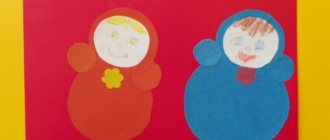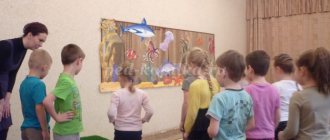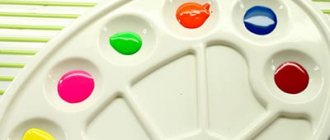Didactic games for preschoolers 4-6 years old on the topic: Fruits, vegetables, berries
Didactic games for preschoolers on the topic: “Fruits, vegetables, berries”
Author: Knis Anna Nikolaevna, senior teacher. Place of work: MBDOU “Kindergarten No. 3 “Smile”, Kalach - on - Don. Description of work: I bring to your attention didactic games for preschoolers on the topic: “Fruits, vegetables, berries.” This material will help educators, children and their parents consolidate children's knowledge about fruits, vegetables and berries in a playful way. Didactic game “The fifth odd one” Goal: Development of skills to classify objects according to essential characteristics, consolidation of generalization words. Didactic material: Cards depicting five objects, four of them belong to one thematic group, and the fifth to some other group. Progress of the game: Children are given the task: “Look at the pictures, name what is depicted on them and determine which object is superfluous. Name the remaining items in one word.” Each participant eliminates the extra item in turn. If he makes a mistake or does not complete the task, his version is offered to the next player to complete. For each correctly completed task they give a chip. The one who collects the most chips wins. Cards for the game: 1. Strawberry, raspberry, kiwi, blackberry, currant. The extra kiwi is because it is a fruit and the rest are berries.
2. Tomato, eggplant, pepper, potato, banana. The extra banana is because it is a fruit and the rest are vegetables.
3. Gooseberries, peach, cranberries, currants, blueberries. The extra peach is because it is a fruit and the rest are berries.
4. Kiwi, apple, pear, peach, tomato. The extra tomato is because it is a vegetable and the rest are fruits.
5. Oranges, apples, radishes, lemon, banana. The extra radishes are because they are vegetables and the rest are fruits.
6. Pear, radish, garlic, cucumber, cabbage. The extra pear is because it is a fruit and the rest are vegetables.
Didactic game “Shop “Fruits, Vegetables, Berries” Goal: Developing children’s skills to accurately describe the appearance (color, shape), taste, and place of growth of fruits, vegetables and berries. Didactic material: Models of fruits, vegetables and berries. Progress of the game: Children choose a seller. The buyer approaches the table on which the models are laid out. Without naming, he describes the fruit, vegetable or berry he wants to buy. For example: “I want to buy berries. They grow in the forest on small bushes. The berries are small, dark blue, round, like peas, slightly flattened on top, juicy and sweet. Jam and compote are prepared from these berries” (blueberries). The child must describe the selected item in such a way that the seller understands what he wants to buy. The seller sells fruits, vegetables and berries (gives the dummy) only to those who have completed the task correctly. Didactic game “Whether in the garden or in the vegetable garden” Purpose: To develop children’s skills to accurately determine the place where fruits and vegetables grow. Didactic material: Pictures of fruits and vegetables, a picture of a vegetable garden and a picture of a garden. How to play: 2 children or 2 groups of children play. The teacher gives one child (group) a picture of a vegetable garden, and another child (group) a picture of a garden. Pictures of fruits and vegetables are laid out in front of the children. A child (group) who has a picture of a garden is collecting vegetables, and a child (group) who has a picture of a garden is collecting fruits. At the end of the game, children check with each other whether they completed the task correctly. Task options: - one group comes up with a riddle about vegetables or fruits, and the other group must find and show the answer in the picture; - tell what can be prepared from vegetables (fruits).
We recommend watching:
Didactic games (verbal) for children 5-6 years old Didactic game for children 5-6 years old Didactic game for teaching literacy to older preschoolers Didactic game for teaching literacy to older preschoolers
Similar articles:
Games to develop motor coordination for children 5-7 years old
Didactic games with natural materials for older children in kindergarten
Educational games for children 5-6 years old in kindergarten
Didactic games to familiarize yourself with flora and fauna for children of the senior preparatory group
Didactic games to familiarize yourself with the outside world in the preparatory group
Lesson on the topic “Vegetables and fruits”
Summary of a lesson on familiarization with the environment
for children with special needs level 3, 3 years of study
on the topic "Vegetables and fruits"
Tasks:
To consolidate children's ideas about fruits (apple, pear, orange) and vegetables (tomato, cucumber, carrot): name, appearance, place of growth, who plants.
Exercise children in determining the qualities of vegetables and fruits: shape (round, elongated), color (red, yellow, green, orange), forming phrases (noun + adjective).
Strengthen the ability to differentiate vegetables and fruits.
Strengthen the ability to form singular and plural nouns in speech.
Develop visual, tactile perception, concentration, attention span, verbal memory, visual-figurative and verbal-logical thinking.
Help strengthen the ability to answer questions in complete sentences.
Help consolidate the ability to act in accordance with the teacher’s instructions.
Cultivate a desire to help others.
Integration of educational areas:
physical development, speech development, artistic and aesthetic development.
Vocabulary work:
a lot
,
gardener, gardener.
Preliminary work:
Examination of plot paintings on the topic “Vegetables and fruits”
Reading the fairy tale “Turnip”
Individual work:
With Ksyusha
to improve skills in naming vegetables and fruits and arranging them on plates
With Katya
to improve the ability to write simple sentences on issues
Materials and equipment:
Demonstration: Olympic bunny, bag, ball, pictures of beds and trees
Handout: 2 plates, natural fruits and vegetables (apple, pear, orange, carrot, tomato, cucumber), gifts for children.
Progress of educational activities
Organizing time:
There's a knock on the door and the Olympic bunny runs in
Hello, guys, I'm the Olympic bunny, I brought you a wonderful item from the Olympics, and it's wonderful because it is given only to winners.
The bunny shows the bag.
What is this wonderful object? (children's answers). Pouch.
Nobody knows what's in the bag except the winners, they gave me a clue, but I can't figure it out. Help me guys.
Main part:
During all the game exercises, I stimulate the children’s speech activity by asking clarifying questions and questions to describe their actions.
Game exercise “What’s inside?”:
Let's help Bunny find out what's in his bag.
Now each of you will put his hand into the bag and try, without looking, to determine what he got into his hand, and tell him why you decided so.
Children take turns placing their hand in the bag and, using tactile inspection, guess what is in their hand. These items are left on their plates.
Guys, what was in Bunny’s bag? (children's answers). The bag contained vegetables and fruits.
Let's tell you what they are.
Children take turns making up phrases that describe a specific fruit or vegetable, for example, a green apple.
Game exercise “What grows where?”:
To carry out individual work, I ask questions as support for drawing up a proposal
Bunny: - Now I know what was in my bag. But I don't know where all these vegetables and fruits grow.
Let's tell and show Bunny where each vegetable and fruit grows.
Where do vegetables grow? (children's answers). Vegetables grow in the garden.
Where do fruits grow? (children's answers). Fruits grow on a tree.
I hang pictures of beds and trees on the board.
Where do vegetables grow? (children's answers). Vegetables grow in the garden.
Guys, who grows vegetables? (children's answers). The vegetables are grown by a gardener.
Where do fruits grow? (children's answers). Fruits grow in the garden.
Who grows the fruit? (children's answers). The fruit is grown by a gardener.
I show a picture of a fruit or vegetable and the children name it. I ask who grows it. Then, whoever named it correctly comes out and hangs it on the board.
Now do you understand, Bunny, where vegetables and fruits grow, and who plants them?
Hare: Got it, thanks guys.
Game exercise “Decompose”:
Look, we have all the products mixed on the table, let's help Bunny arrange the items so that he can better understand. I have two plates: in one plate we will put fruits, in the other we will put vegetables.
I divide the children into 2 teams: 1 team lays out vegetables, 2 - fruits. At the end of their activity, we check whether everything is laid out correctly.
Game exercise “One-many”:
The Olympic Bunny wants to see how dexterous and smart you are.
I throw a ball to each of you and name a fruit/vegetable in the amount of one item, you must catch the ball and name the same fruit/vegetable so that there are a lot of them.
For example: There is one apple, but there are many... (apples); There is one cucumber, but there are many... (cucumbers); There is one pear, but there are many... (pears), etc.
I throw the ball to each child in turn and name the fruit or vegetable in the singular; children catch the ball and, pronouncing the same vegetable or fruit in the plural, throw the ball back.
Look, Bunny, how dexterous and smart the guys are, they haven’t made a single mistake!
Final part:
What did we talk about today? (children's answers). Today we talked about vegetables and fruits.
What vegetables and fruits? (children's answers). About apple, pear, orange, tomato, cucumber, carrot.
Where do fruits grow? (children's answers). Fruits grow in the garden.
Where do vegetables grow? (children's answers). Vegetables grow in the garden.
Who grows vegetables? (children's answers). The vegetables are grown by a gardener.
Who grows the fruit? (children's answers). The fruit is grown by a gardener.
Qualitative assessment of children’s activities: I praise and note those who were more active and took direct part in the lesson.
Bunny, did you like how our guys did the lesson?
From the Hare's perspective:
Guys, you are so great! I really enjoyed playing with you. You were all so smart and quick-witted! You helped me figure out what was in my bag. For this I want to give you small gifts as souvenirs.
The hare gives gifts to children.
And now it’s time for me to return to the Olympics.





